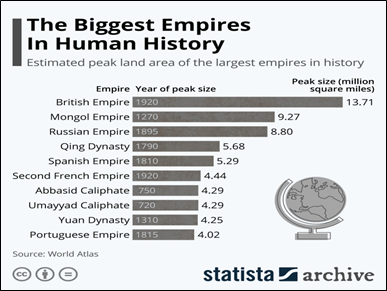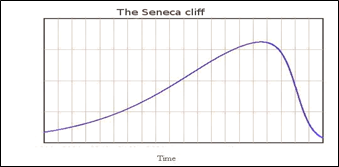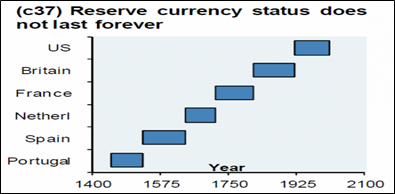Great powers in history
“If something cannot go on forever, it will stop”
Stein’s Law
Great powers are the key players both in the theoretical context and in the reality of international relations. Therefore, the destinies of empires / unipoles are so important to follow up and examine in details.
In the history of the humankind, empires have been built through the creation or acquisition of wealth.
The Roman Empire came about through the productivity of its people and its subsequent acquisition of wealth from those regions that it invaded.
The Spanish Empire began with productivity and expanded through the use of its large armada of naval force, looting the gold worldwide.
The British Empire began through localized productivity, industrial revolution, and grew through its creation of colonies worldwide – colonies that it exploited, bringing the wealth back to England to make it the wealthiest country in the world. In the Victorian Age, the Brits could say “The sun never sets on my flag.”
Even the “eternal” Soviet Union with the communism faced the final destiny after seventy years with iron ruling.

From the 13th to 21st century, the world has seen numerous empires and great powers coming and going like
- Ottoman Empire (1299-1923),
- France (1450-1815),
- China under Qing Dynasty (1636-1912),
- Safavid Persia (1501-1736),
- British Empire or Great Britain (1600-1956),
- Russian Empire and Soviet Union (1400-1990),
- Empire of Japan (1863-1945) and
- the United States (1900-present).
Now coming to the present empire, the United States of America, the issue of the destiny does not deviate from those historical examples mentioned above. The overall historical continuum of empires and the basic conformities to law, dictate the demise of the US as well.
The present position of the unipole, the US, can be analyzed in the context of collapsism framework and can be carried out by two key drivers – external and internal drivers.
The concept of collapsism has been examined on this website here. Two classical documents on the subject “collapsing of great power” (Paul Kennedy 1989 and Joseph Tainter 1988), among others, form a theoretical base and comparable “benchmark” in assessing the prevailing situation.
Some recent researches have forecasted the decline of unipolarity taking place soon. Robert Pape in his article “Empire Falls” (2009) argues that “the US is in unprecedented decline and it means the unipolar world is coming to an end. Along similar lines, Christopher Layne (2012) argues that unipolar moment is over and the era of American ascendancy in international politics is fast winding down. He explains that there are two drivers of American decline, one external and one domestic.
Seneca Cliff
The Roman philosopher Lucius Annaeus Seneca once wrote that: “increases are of sluggish growth, but the way to ruin is rapid.” Later this concept was coined as Seneca Cliff or Seneca Trap which graphically is presented below:

This concept is worth to keep in mind when various vicious circles of today are becoming visible in modern complex societies and all kinds of bubbles are going to be burst in the near future.
However, enigma of human inability in understanding historical discontinuities seems to be valid also with today’s research society.
Overwhelming majority of present Western economists and other economic pundits are not able or willing to understand or accept such a possibility that the present position of international reserve currency (the US dollar) could somehow downfall, not to mention the collapse. The Sino-Russia joint scheme of de-dollarization has been left nearly totally unnoticed by Western researchers. Consequently, the life of any fiat money, including reserve currencies, has not been so long as seen in the picture below.

This topic will be analyzed and discussed several times on this website, some coming blogs will deal with cases of present time.


